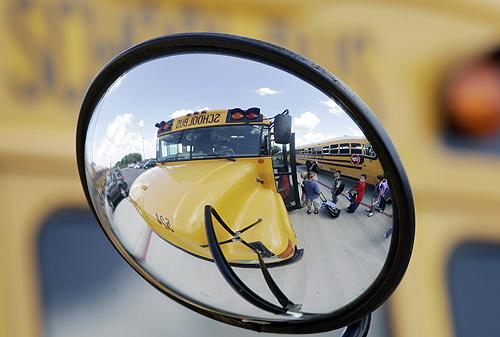Parents lead push to have seatbelts on school buses

Students are reflected in a mirror as they board school buses at Fisher Elementary following the first day of classes in San Antonio on Aug. 27. A national debate is churning over whether seat belts, a decades-old vehicle safety feature, should be requir THE ASSOCIATED PRESS, ERIC GAY
September 5, 2007
“Buckle your seat belt,” that famous parental admonition, is the undisputed law of the land in the back seats of minivans across America. Yet as school buses hit the road again this fall, those big yellow machines will transport millions of unrestrained children to class on buckle-free seats.
Several recent accidents – including the fall of a yellow bus when the Minneapolis bridge collapsed – have brought new attention to a national debate over whether seatbelts, a decades-old car safety feature, should be required on school buses.
“Every time a bus stops short, kids get smashed (against the seat),” says Dr. Alan Ross, president of the National Coalition for School Bus Safety, an advocacy group. “Do you know how many times a vehicle stops short to avoid accidents?”
About five children are killed in school buses every year, according to the Transportation Research Board, making it the safest form of transportation in the United States. But a study published in the November 2006 issue of Pediatrics showed 17,000 children are injured in school bus accidents each year, more than double the previous government estimate.
The federal government has rejected mandating seat belts in favor of “compartmentalization” – keeping kids in narrow spaces with high seat backs that are energy-absorbant.
Get The Daily Illini in your inbox!
The American Academy of Pediatrics, among others, says this safety measure proves inadequate in side-impact and rollover crashes.
“One of my patients came in, and her teeth were knocked out in a school bus crash. She’s seven years old and she has dentures,” says Dr. Phyllis Agran, a co-author of the AAP study.
The controversy is polarized by disagreement among government officials, creating a legislative impasse in several states. Frustrated by the inaction, some concerned parents are taking matters into their own hands.
“All you have to do is look at the crash videos,” says Steve Forman, a parent in Beaumont, Texas. “Crash test videos that show dummies and exactly what happens to your child in a bus accident.”
Forman’s 18-year-old daughter, Allison, experienced the full force of a rollover bus accident while en route to a soccer playoff game in Houston on March 29, 2006. Trapped beneath the motor coach bus, Allison’s left arm was crushed and mangled. Two of her teammates were killed and several others were seriously injured.
Besides Texas, only five states – California, Florida, Louisiana, New Jersey and New York – have any safety belt requirements for school buses. California and Texas remain the only states mandating three-point lap and shoulder belts.






